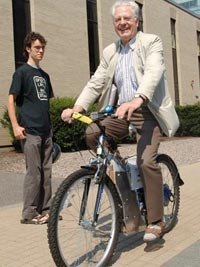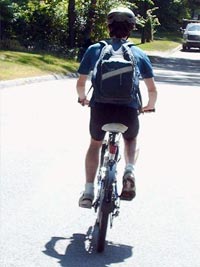
It’s not often that an MIT freshman gets to outperform his professor. That’s what happened when Nicholas Joliat ’10 beat Physics Professor Ulrich Becker home during evening rush hour traffic. Both left MIT at 6 p.m. headed west toward Lexington, with Joliat on an experimental electric bike and Becker in his car.

“We both went up Mass Ave. and agreed to meet in Arlington Center,” says Becker, who built the “electro” bike. “I didn’t see Nick, so I waited 15 minutes. As it turned out, he was at a different location ahead and had been waiting for me for 20 minutes.” Although Joliat got to Arlington Center first, Becker arrived two minutes earlier on the remainder of the trip to Lexington. Overall, Joliat covered the total 12.4 miles a few minutes faster. There was an even bigger difference in the cost of energy used. Joliat used about 10 cents worth of electricity, as measured by the amount of recharging needed for the bike. Becker used about $2.03 worth of gas. “The bike will pay for itself fast,” Becker says. While commuters also can opt to use the commuter rail, they first need to travel to nearby Concord or Alewife to pick up the train. Electric bikes have been around for a while, but Becker says his prototype is far more efficient than earlier bikes. The bike is fitted with a high-efficiency motor built using high-strength magnets originally developed for an experiment aboard the Space Shuttle. The motor, situated virtually unnoticeably in the hub of the back wheel, can drive longer and does not get hot. There also are a few inexpensive controls, such as a throttle-type mechanism in the handlebars to control speed. The extra gear to electrify the bike adds about 22 pounds in weight, an amount Becker hopes to decrease in future versions.

“To prove economy for the bicycle, I used four cheap 12-volt batteries costing $32 total plus an $88 bike I bought on sale at a department store,” he says. It works like a bike, but silent power can assist anytime. “When I rode it, it was marvelous. It’s good on hills for older people like me,” he says. Age isn’t a prerequisite for enjoying the bike. Joliat also appreciated being able to rest a bit on hills after a long day at MIT, letting the electric motor do the work instead of pedaling all the way. “I’d consider using it to commute,” says Joliat, 20. “The bike would appeal to MIT students. It’s cool and the technology is interesting. And I like that it is made of cheap components.” It’s just such involvement by students that MIT’s Energy Initiative, or MITEI, hopes to incite. “In addition to performing research, MIT can have an impact by demonstrating best energy practices on campus. Students can then take those practices to a company as they go up the management chain,” says Steven Lanou, deputy director of the sustainability program in MIT’s Environmental Programs Office and a leader in campus energy initiatives. “There’s a multiplier effect.” MITEI aims to “walk the talk” in adopting model energy practices on campus. The institution is one of the largest energy consumers in Massachusetts. MIT conducted a campus emission assessment in response to the City of Cambridge Climate Protection Plan that calls for a 20 percent decrease in greenhouse emissions from 1990 levels by 2010. Based on 2003 levels (the year the assessment was conducted), MIT would need to decrease its emissions 22 percent to meet the city’s goal, according to a 2004 master’s thesis by mechanical engineering student Tiffany Goode. Most emissions are from campus buildings, but 9.5 percent is attributed to commuters. In its most recent biannual commuter survey, 25 percent of off-campus commuters said they drove alone to MIT compared with 75 percent nationwide. About 7 percent of off-campus residents biked. Lanou finds the electro bike intriguing and says MIT is actively promoting alternative transportation to, from, and around campus. Even though Becker’s experimental bike isn’t formally part of the program, the professor thinks the bikes could be a real hit with students. “This also could help relieve traffic a lot if many people did it,” he says. “The bike path on Beacon Street in Cambridge is a good start.”